This was published 5 years ago
Best forms of transport for travellers: Seven iconic experiences for your bucket list
By Traveller
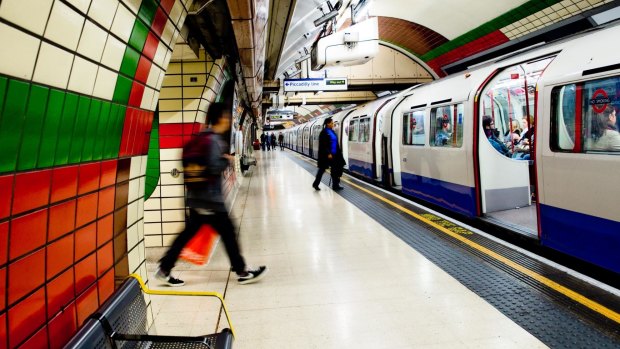
London Underground's Piccadilly Line from Heathrow is many Australian travellers' introduction to the English capital.Credit: Shutterstock
Without transport, there would be little travel, apart from those excellent journeys of the mind, known as "transports of delight". Occasionally, our travel stars align into treasured experiences, a serendipitous fusion of circumstances defined by something quite humble – the form of transport.
The vehicle itself isn't something we generally think too hard about. If we're lucky, a magic moment might materialise. Sometimes, however, people choose a particular mode to connect with a significant time or event.
Travellers often retrace iconic journeys using specific forms of transport – such as driving Route 66, which John Steinbeck dubbed "the Mother Road" in his 1939 novel, The Grapes of Wrath – to reimagine the east-west expansion of the US.
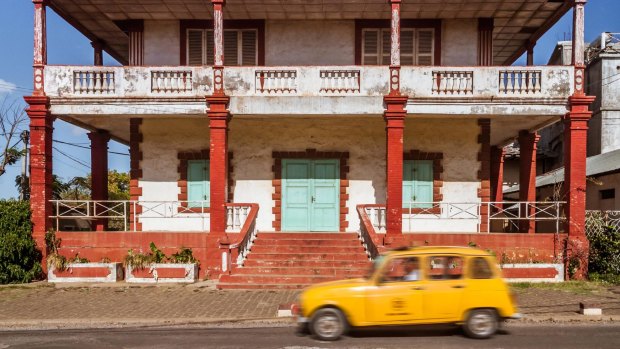
The taxis in Madagascar are all old French workhorses.Credit: Shutterstock
Similarly, train aficionados may seek to relive rail's Golden Age by boarding one of the most storied trains, the 1883 Venice Simplon-Orient-Express. Egyptophiles might revive the annual Nile River progress of the ancient pharaohs in a traditional sailing boat, or dahabiya.
Intrepid travellers may consider (probably only momentarily) entering the gruelling Mongolian Derby on semi-wild Mongolian ponies, tracing Genghis Khan's 1000-kilometre ancient postal route.
Specific forms of transport offer different perspectives. For example, on the Royal Canadian 1920s vintage train route, there are the actual train travellers and there are the train-spotters staking out the route with their tripods and cameras. And finally, there are the backpackers simply seeking to hitch a ride.
Delight doesn't need to involve epic journeys. It could be a balloon flight, streetcar ride, pony trek, husky-drawn sled, ferry, mountain bike, tuk-tuk, gondola, toboggan or perhaps one of the diverse and far-flung conveyances that Traveller writers offer as their choices. - Alison Stewart
SEEING SICILY BY SCOOTER
By Ben Groundwater
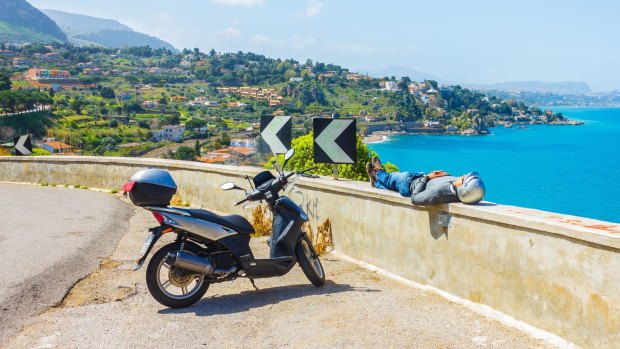
Credit: SHUTTERSTOCK
There's a whoosh of warm breeze, a flash of red, the howl of a straining engine, and then nothing, once again. Fresh air. Open road. I've just been overtaken. Again. That whoosh wasn't a sports car or an urban-tractor 4WD, it was a Fiat Uno, its accelerator pressed to the floor as its pilot tore a course around me. And now he's disappeared behind another bend in this windy, beautiful road and I'm alone.
I've been overtaken a lot in the past few days; Sicilians are in a hurry. What they're in a hurry for I'm not sure, given no one seems to do much around here but lie on the beach, eat gelato, wander the boardwalks and take selfies. Maybe they're just in a hurry to get back to that. It's been four days since I began this journey, a circular route beginning and ending in the touristy town of Taormina. In the past four days I've cruised down coastlines and navigated cities, I've wound through farmland and skirted hills, and I've done it all on a scooter, on a two-wheeled steed, the ultimate transport to see Sicily, and the world.
A scooter is freedom; a scooter is living. Aboard this little machine you don't just see Sicily, you feel it. You taste it. You smell it. At various times you also dodge it, you honk your horn at it, you widen your eyes in fear at it, you glory in it, you laugh at it and you drink it all in.There's never a dull moment on a scooter in Sicily.
Ever since I pointed my front wheel south, as I took in the twin vistas of the Mediterranean sparkling to my left and Mount Etna smoking to my right, life has been good, it's been right. I've tasted salt in the air as I've hugged the beach at Giardini Naxos. I've caught the scent of olive groves as I've cruised through the island's interior. I've felt the sheer, unadulterated joy and freedom that the wind on your face and the sun on your arms and two wheels sticking to hot tar brings.
I've also had to deal with Sicilians. I've had to process the fact that no one indicates here, no one sticks to the speed limit, people overtake on blind corners and roar past you without a care. It lends an incongruous feeling of hurry to a placid isle.
But you get used to that. In fact, you join it. You embrace Sicilian style on this most Italian of vehicles. You gun the engine, you ignore the indicators and you just go.
And then all that's left is those open country roads, those winding hilltop ascents, those choked boulevards in those sultry, beachy locales. The warm air. The hum of an engine. The feeling of being free.
Scooter hire in Taormina is available through California Rentals; automatic 150cc scooters start from €40 per day and a valid motorcycle licence is necessary. See californiarentcar.com
See also: Sicily: The most beguiling island in the Mediterranean
A VINTAGE TAXI IN MADAGASCAR
By Ute Junker
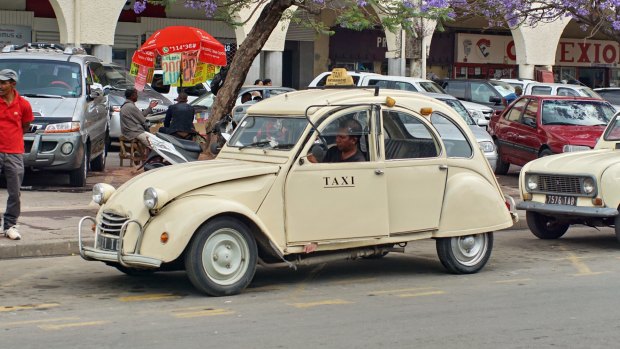
Credit: SHUTTERSTOCK
To my mind, Citroen 2CVs belong in black-and-white French films. You know the sort of thing, some moody piece starring Jean-Paul Belmondo or Alain Delon strolling along a sidewalk while 2CVs pootle past. The idea of these compact cars cruising actual streets seems a little absurd, particularly since the last one rolled off the line almost 30 years ago.
Which is why I was surprised to find hordes of them clogging the streets of Madagascar's capital, Antananarivo, where they are the car of choice for the city's taxi drivers. At least, most of them.
Some cab drivers plump for another French workhorse, the Renault 4. So popular are these two makes that a walk through the streets of Antananarivo can feel like a visit to a vintage car rally.
Visitors who come to this island for its superb wildlife viewing and eye-catching scenery are often nonplussed to find these French classics clogging the streets of a city more than 8000 kilometres from Paris. Just like Cuba's famous fleets of vintage Cadillacs, Madagascar's stylish taxis reflect the island's poverty. Both the Citroen 2CV and the Renault 4 are known for their durability and for their affordable spare parts, two considerations that trump all other aspects, including comfort.
There is no denying it: watching these butter- and cream-coloured classic cars cruise the streets is often a lot more fun than actually riding in them. If you do flag one down, expect lumpy seats and, on an uphill climb, a complaining whine from the engine that sounds like the war cry of a seriously pissed-off giant mosquito.
And in Antananarivo, hills are hard to avoid. The city is spread over three levels, each of which has its own character. The city's upper levels – all quiet tree-lined streets, colonial buildings and chic little bistros offering plates of foie gras for less than $10 – stand in contrast to the lively chaos of the Lower Town, where makeshift markets are fragrant with the scent of vanilla beans and frying zebu sausages.
In a country where the average annual income is just $US400 ($540), the locals have learnt to make the most of what they have, and that is doubly true of the country's taxi drivers.
Many vehicles are kept running through an inventive range of DIY improvements, with home-made fuel hoses being one of the most popular interventions.
Be aware that the seats may not be the only things that have holes in them; as I stepped into the back of one taxi, I only narrowly avoided putting my feet through a cavity in the floor.
Most impressive is the way that Malagasy drivers have learned how to eke the most out of every cent. Once you have agreed on a fare, don't be surprised if your cab driver tops up his petrol tank from a small jar of fuel. With fuel verging on being a luxury item, drivers carefully measure out every drop.
Madagascar's taxis are cheap; you are unlikely to spend more the $4 on a cab ride.
See madagascar-tourisme.com/en
See also: An island of unimaginable landscapes
THE SLOW BOAT DOWN TO MALE
By John Borthwick
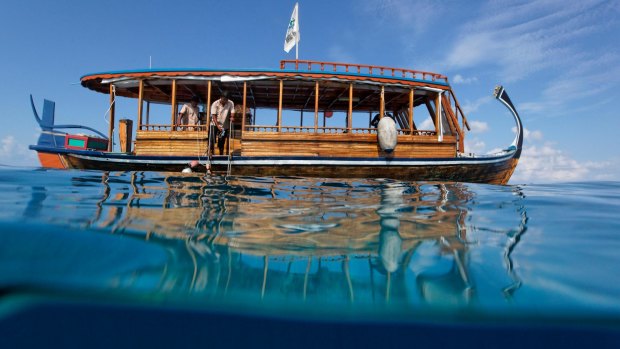
Credit: Alamy
There's more to a good island holiday than a flash spa perched on a sandbar. Sometimes you've just got to get off the rock. If your velvet Alcatraz happens to be in North Male Atoll in the Maldives, the best escape is a day trip to the big smoke, the capital, Male.
At reception they suggest the resort's state-of-the art launch. With triple outboards howling, it can race you flat-chat through a slew of paradise postcard islands to reach the capital in just 30 minutes.
Much better, wrangle if you can a ride on a ferry or local dhoni and spend a few vagrant hours chugging down to Male, slow-boat style. Which is how transfers were done when tourism began in this atoll in the early 1970s and for several decades after.
Back then, instead of a hammering speedboat you boarded a traditional Maldivian dhoni with a wide-bellied hull and tall, scimitar-shaped bowsprit. Originally designed for sail-power, later dhonis installed inboard diesels but still kept their heroic prows. The first ones I saw looked like Viking longboats with sunstroke.
"One of the wonders of the world," wrote 14th-century traveller Ibn Battuta, describing the Maldives. Scholars speculate that the archipelago's name came, aptly, from the Sanskrit term for "garland of islands". Marco Polo too reckoned the place to be "the flower of the Indies", although he only saw (or imagined) them from sea level. Look down from a plane some time and behold the Maldives as Marco never could – 1192 reef-ringed islands looping down the Indian Ocean in a daisy-chain of 26 atoll clusters.
Plumed swells burst along the North Male reefs and sandy cays hover mirage-like on the lagoon as your dhoni plods south. The only other vessels moving at this pace are dive boats and wave-hunting surfari dhonis. As you pass little Kanuoiy Huraa Island you can see the perfect left-handers wrapping around its celebrated Pasta Point, not that you'll find the place on any chart.
True to surfing's eccentric cartography, these wave-rich reefs are littered with eponymous nicknames such as Chickens, Sultans, Honkys and Jailbreak (the latter breaking in front of the former national jail). Many of them were bestowed by Sydney surfer, the late Tony Hinde, who was shipwrecked here in 1973 and thereafter found no compelling reason to go home. "Surfing in Sindbad's shadow," was how he described his extraordinary life here.
Drawing closer to the city, you see that many previously uninhabited cays have been luxuriously transformed to designer islands, so to speak. Boardwalks stretch out from them like exoskeletons, spanning the lagoon towards svelte castaway suites and driftwood palaces.
The maritime traffic too intensifies here as shuttle boats, ferries, scows and construction vessels crowd the channel. Even so, a squad of dolphins leaps past, almost in unison, sprinting towards the town and its golden-domed mosque, as though late for work or worship.
Predictably, Male's harbour esplanade has changed, gone modern, upmarket. Making way for the new, the historic cannon bollards that lined the old quay have disappeared. Most of the classic Viking-prowed dhonis too have gone, perhaps to sunstroke Valhalla, but a few slow-boat-to-Male memories still chug on.
In North Male Atoll, Cinnamon Dhonveli Resort on Kanuoiy Huraa Island operates surf, dive and excursion trips by dhoni (as well as speedboat transfers). See atolltravel.com
See also: Why you need to visit this island paradise's tiny capital city
CANOE DOWN THE ZAMBEZI
By Alison Stewart
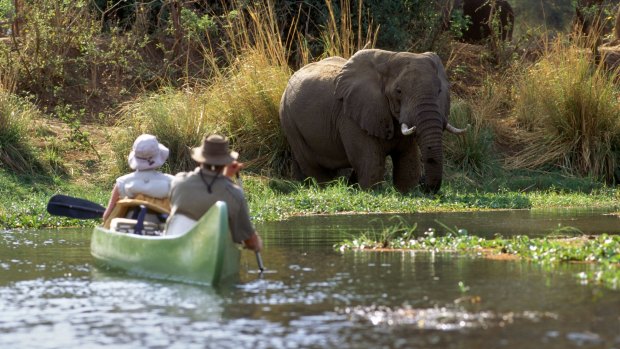
Credit: Alamy
Like a violin, the canoe is an instrument of both delight and torture. Handled properly, it sings through the water. Improperly, and it is a peevish beast.
I have never quite mastered it, but without it, I could never have realised a dream to paddle the Zambezi's wild waters, braving cerebral malaria, bilharzia, tsetse fly and man-eating Nile crocodiles, while dodging hippos.
There is a certain chilling pinkness to the gullet of a hippo. And the teeth are indeed rather large, and yellow.
But when you get it right, oh the miracle of it. My 5.5-metre-long Canadian-style two-man canoe is that elegant wormhole to a different universe, the middle Zambezi, which borders both Zimbabwe and Zambia – a quixotic wonderland of savagery and peace, silence and fury, beauty and terror.
It's a way to be alive, which lies at the heart of all travel. Africa's longest east-flowing river cradles some of the continent's most pristine wilderness. It's the river of explorers – including my great-grandfather, Dr James Stewart, who paddled part of it in a canoe. This is my motivation.
There are those serendipitous moments when the canoe responds to the mysterious C-strokes and J-strokes and sweep strokes, when it obediently threads the needle between territorial hippo pods.
This is when you are part of the river, at one with the peaceful splashing of paddle and hiss of craft on water. This is when you get close to the great herbivores and predators that descend to the Zambezi's shallow pools to feed on the riverbank's sweet grasses, sausage trees, baobabs and the winter thorn pods.
Your passage downstream, with Zambia's 1000-metre pink-and-blue misty rift escarpment to your left, comes accompanied by the bird calls of riverbank-nesting Carmine bee-eaters, African skimmers, Pel's fishing owl and Nyasa lovebirds.
The river itself has a sound – an insistent sighing as it travels down to its Mozambican delta mouth. It's this broad, swift-flowing water – about six kilometres an hour – that creates the canoe conundrum. To stay in deep water with the current requires skill but avoids deep-water-disliking hippo.
Or spin and bump into the shallows risking the bane of guides – hippo fixation – "paddle fast, hit bank". Or "hippo strike" when a 3000-kilogram vegetation-distilling vat "banzaies" off the bank, after which time, according to our guide, "you roll in a ball and float down the river until rescued."
The canoe fits the Zambezi like bark on a tree. It leaves no trace, heightens the adventure, honours history and perfectly fits the experience.
I have just cycled part of the Camino. I should have walked.
Experienced operators include Natureways Safaris or Zambezi Safari & Travel Company for a choice of basic or luxury multi-day canoeing and camping safaris. See natureways.com and zambezi.com
See also: Africa: The destination that offers everything - adventure, luxury, danger, booze
THE LONDON UNDERGROUND
by Tim Richards

Credit: SHUTTERSTOCK
Many cities have underground railway networks, but none of them has the quirky, appealing personality of the world's first: the London Underground.
As it's been built in fits and spurts since the 19th century, the Tube possesses none of the bland uniformity of more recently built systems. Instead, it's an eclectic collection of routes, from lines just below ground level, to lines running through tube-shaped tunnels deep beneath the city streets.
The most atmospheric stations are those that opened along the first line in 1863, from Paddington to Farringdon. Standing on one of the oldest platforms at Baker Street Station, with its curving brick roof, it's easy to fantasise stepping aboard one of its long-vanished steam trains alongside Sherlock Holmes.
What binds these disparate lines together is the Tube map, designed in 1931 by Harry Beck. Realising there was no need to place stations at their correct distances from each other, he produced a map resembling an electrical circuit diagram. It was an immediate hit and an instant design classic.
That map also reflects a key element of London's appeal – its quirky place names that suggest intriguing backstories: Seven Sisters, Swiss Cottage, Elephant & Castle. Stations such as Monument, Barbican, Temple and Charing Cross hint at historic relics, while central stops such as Piccadilly Circus and Leicester Square promise the bright lights of the West End.
As for the trains, they're as diverse as the network they run on. The Elizabeth Line, which opens this year, will be served by a fleet of new 200-metre-long trains with airconditioning and interconnected carriages.
For my money though, the classic Tube ride is aboard one of the trains which were designed in the 1970s and still serve the Piccadilly Line. With their distinctive semi-circular roofs, they seem like long metallic centipedes perfectly adapted to their tubular habitat. Inside, their cushioned blue seats with chunky red armrests run along the walls rather than facing each other in sets, helping to maintain the Tube tradition that passengers should avoid eye contact and never speak.
There's something special about riding in one of these carriages, perhaps leaning on the small upholstered ledge at one end, crammed in with near-silent Londoners as you rattle through a strange dark world beneath one of the most exciting cities on Earth.
Stepping out into a central station with its tiled walls and posters plugging West End musicals, there's a sense of anticipation as passengers file upwards via pedestrian tunnels and long escalators. Voila! We're suddenly in a different part of London, and it's all happening. The Tube is like one big magic trick. And if, like so many Australian travellers, your first experience of London is the long Piccadilly Line ride from Heathrow, you get to snigger at the frequent announcement: "This is a service to Cockfosters."
Don't feel bad, we've all done it.
An entertaining history of the Tube is Underground, Overground (profilebooks.com) while the author's fantasy novel, Mind the Gap, also features the Tube (harpercollins.com.au). For maps and fares, see tfl.gov.uk
See also: London's hidden underground railway opens to the public
AN AIRBOAT IN THE NORTHERN TERRITORY WETLANDS
By Brian Johnston
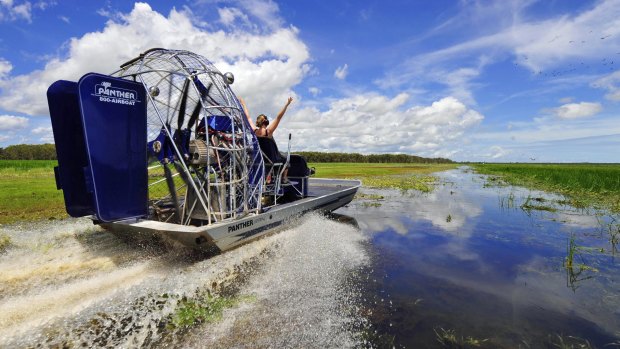
My first experience of an airboat – which I've long associated only with Florida – is out on the Mary River flood plains of the Northern Territory in the company of guide Dean Hoath.
We mosey through paperbarks trunk-deep in water and out onto open wetlands. Confetti flocks of egrets and terns are white against the hot blue sky. Cormorants brood on rocks, wings spread. Two grey brolgas with distinctive red head patches dance on the riverbank like novice ballerinas.
Even Hoath, who's been here many times, is still impressed at the exhilarating sense of space. "Just think, this is only one corner of an unimaginably vast land. You have to imagine this scenery and abundance of wildlife repeated for 90,000 square kilometres. It really is unknown Australia."
The Mary River system is one of Australia's most important ecosystems, yet scarcely known. We've headed out from luxury lodge Bamurru Plains, whose airboats are the shuddering, rattling workhorses of the water, their shallow drafts allowing us to inch into its most beautiful corners, carpeted with profusions of purple water lilies.
This is what I love about airboats: they blow you into places otherwise inaccessible, making you feel more explorer than tourist.
As the sun sets, Dean pulls wine from an Esky and we pause on pink water to eat canapés as the sky turns red and purple and changing colours chase across the face of the floodwaters. Then we buzz back towards the lodge in the airboat, paperbarks shimmering in the moonlight.
I'm silent with exhilaration. Why have I never been to this part of the Northern Territory before? Who knew it was so beautiful?
Only 200,000 visitors (both Australian and international) come to this vast region each year, and then mostly only to Kakadu. There are few other places you can have entire ecosystems almost to yourself. These wetlands ought to be more celebrated.
They shelter more than 200 bird species, including magnificent sea eagles, egrets, jabirus, herons and jacanas (or Jesus birds) that lurch on spindly legs across waterlily pads. Pelicans float like stately Spanish galleons. Azure kingfishers spark across the water.
Bird numbers are astonishing. Favoured perching trees are weighed down with cockatoos. Whistling ducks and magpie geese congregate in huge flocks. When they launch themselves upwards as our boat approaches, the collective sound of their wings is louder than the frenzied whirl of the airboat's giant fan.
Beneath the water there are silent killers. Popeye mullet jump to escape predatory barramundi. The barramundi themselves are fair game for crocodiles. Freshwater crocs lurk everywhere.
We frequently spot their skinny snouts pushing between the water lilies before they sink beneath our approaching airboat. We finally see one on the riverbank on the last day, enormous in plated armour on a riverbank, bigger than the airboat, as we buzz on by.
Lords Safaris operates personalised small-group tours in Arnhem Land which can include a stay at Bamurru Plains on the Mary River floodplains, and daily excursions by airboat. See lords-safaris.com; bamurruplains.com; northernterritory.com
See also: Kakadu by airboat: A breathtaking experience
THE SAFARI JEEP
By Nina Karnikowski
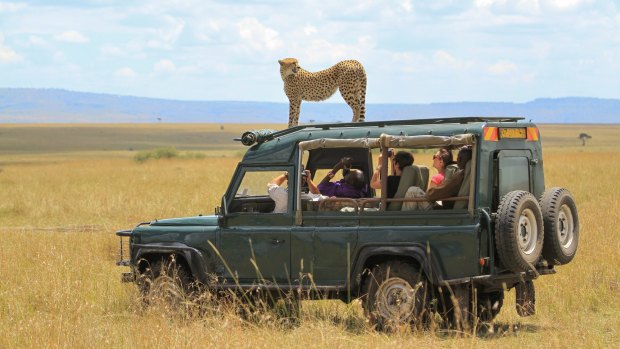
Credit: Shutterstock
The elephant was staring at me. So close I could have reached out and touched its leathery skin; so close I could see its individual eyelashes. I wondered momentarily if that might be the last thing I'd ever see.
If it might decide to use its unfathomable strength to shove our Jeep out of its way and have done with it. But no. Post-gawp it decided to lumber on, leaving us trembling in our seats with a heady mixture of fear and excitement.
It's moments like this one, deep in Kenya's Masai Mara, that I love most about travelling in open-sided safari Jeeps. With no windows and often no real roof to speak of, they put you right at the heart of the action, giving you the ultimate sensory experience.
You can smell, hear and feel it all. The wind on your skin as you bump along the dusty bush trails; the moist scent of earth and wild grasses as they whip by; the calls of the beasts as they interact, barely noticing you at all.
The theory is that animals can't distinguish people in these vehicles. They see us as a kind of moving bush, I've had guides tell me. Over my seven trips to Africa, there have been times when lions have prowled right over to our Jeep and fallen asleep in its shadow, seemingly oblivious to the handful of appetising humans peering down from inside. If we took one step out at that moment though, we'd likely be torn to bits.
It's that element of imminent danger that makes this such an exhilarating way to travel. During one Zambian safari, our truck pulled up beneath an acacia in which a leopard was sleeping, its mottled legs dangling over the boughs.
When someone stood up to grab their camera, the leopard stirred and began hissing into the truck, yellow eyes blazing. It rattled us, sure. But we also felt more alive than we had in a long time.
There's a delicious sense of freedom that this kind of nature immersion brings, too. On a recent sunset drive through Kenya's Samburu reserve, my friends and I stood on our seats, torsos poking out the top of the Jeep and hands reaching out to ride the breeze, singing Toto's Africa as we gunned along.
In the quieter moments, when the vehicle stops for you to observe the animals, it's a form of transport that unfurls you. Out there in the bush, far from the toss of the world, your mind unspools. By day's end, you can feel as if you've sorted your whole life out in your head.
Some of the most memorable safari moments, though, are created just outside the vehicle. Piling out at some spectacular spot at sunset, your guide will flip a small table down from the front of the Jeep, instantly transforming it into a tiny bush bar. There you'll drink G&Ts and chat about the extraordinary creatures you've seen that day, as the sky explodes with colour.
The best part comes once the bar has been packed away. When you're bumping back to camp through the inky night, wrapped up in blankets, nothing between you and the cosmos of stars overhead.
Bench Africa has been organising safaris for Australians for almost 50 years; see benchafrica.com
WRITERS
Alison Stewart, Ute Junker, John Borthwick, Brian Johnston, Ben Groundwater, Tim Richards, Nina Karnikowski
See also: The world's best safari destinations (outside Africa)
See also: Commuter heaven: World's most spectacular local transport
Sign up for the Traveller newsletter
The latest travel news, tips and inspiration delivered to your inbox. Sign up now.